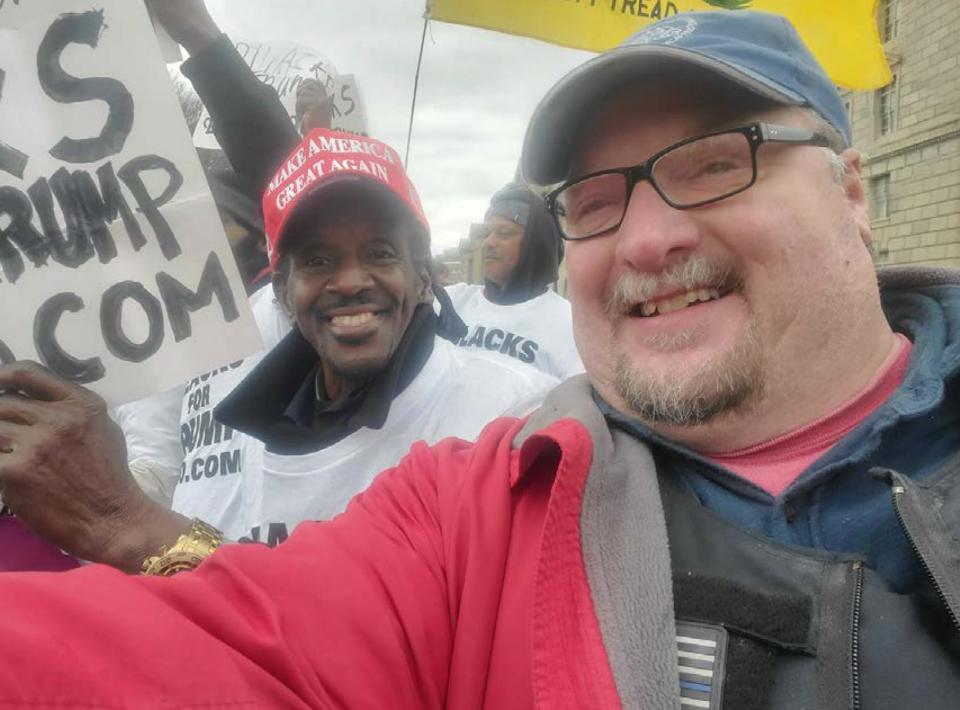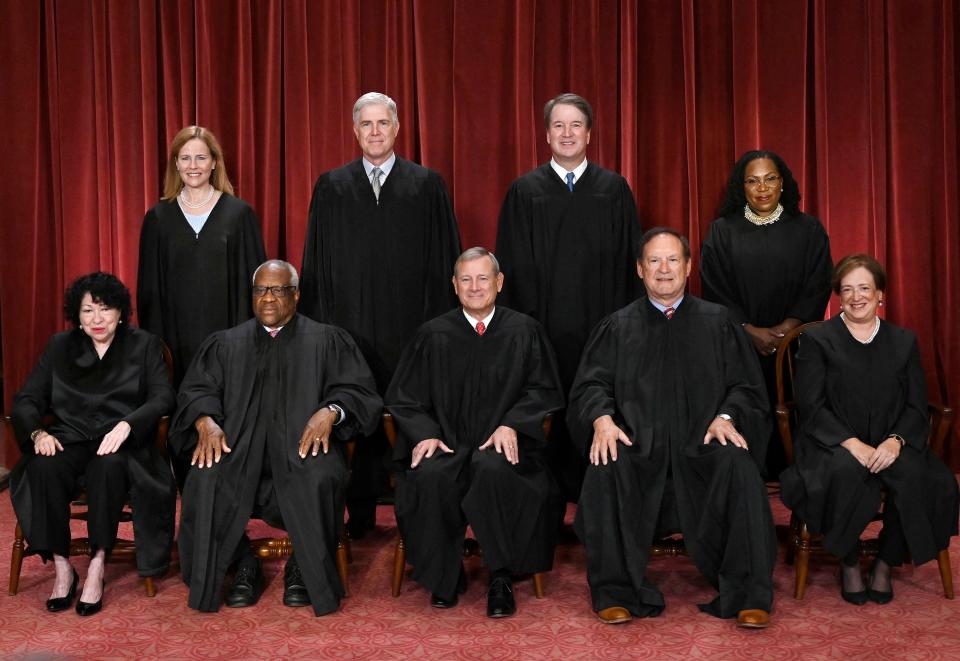Supreme Court grapples with limits on obstruction charge in Jan. 6 cases
- Oops!Something went wrong.Please try again later.
- Oops!Something went wrong.Please try again later.
- Oops!Something went wrong.Please try again later.
- Oops!Something went wrong.Please try again later.
- Oops!Something went wrong.Please try again later.
The Supreme Court grappled Tuesday with the breadth of obstruction charges filed against one-fourth of the defendants from the Capitol attack on Jan. 6, 2021, including former President Donald Trump.
Prosecutors have applied a 2002 law adopted in the wake of a financial scandal so broadly that even peaceful protesters could face 20 years in prison if the government's interpretation is allowed to stand, Jeffrey Green, a lawyer for Jan. 6 defendant Joseph Fischer, told the court.
Green urged the justices to interpret the law narrowly, applying it only to the destruction of documents, and to avoid turning “a catchall provision into a dragnet.”
If the high court sides with the Fischer, a former Pennsylvania police officer, hundreds of people convicted or facing trial for entering the Capitol on Jan. 6 could see their top felony charge dismissed − a victory for those defendants and for supporters, including Trump, who say they were unfairly targeted.
But Solicitor General Elizabeth Prelogar, representing the Justice Department, told the justices that the obstruction law's limits are clear, noting that three-quarters of the Jan. 6 defendants haven’t been charged with it. She argued the law applied to obstructing an official meeting, such as Congress counting Electoral College votes, with corrupt intent − such as threating violence.
Several justices said they were searching for boundaries for what crimes the law should cover.
“We need to find out what are the outer reaches of this statute, under your interpretation,” Justice Samuel Alito said to Prelogar.
Justice Amy Coney Barrett asked about how broadly the law was being interpreted. “Should I be concerned?” Barrett asked Prelogar.

Does pulling a fire arm or heckling at the State of the Union qualify for obstruction charge? Gorsuch asks
Justice Neil Gorsuch and Alito asked whether non-violent protests could be charged. Gorsuch asked whether pulling a fire alarm before a congressional vote, disrupting a trial or heckling the president’s State of the Union speech would qualify for charges with a 20-year maximum sentence.
Alito asked whether a protest in the courtroom would warrant charges if five people standing up to speak about Jan. 6 were removed forcibly, delaying arguments for 5 minutes.
"Has the government applied this provision to other protests in the past, and has this been the government's position throughout the lifespan of this statute?" Justice Clarence Thomas asked.
Prelogar said there have not been previous charges involving protests under the law, but it had been used in cases other than for shredding paperwork, such as in tipping off suspects about a grand jury or about an undercover cop.
In response to Alito and Gorsuch, she said it would be difficult to charge brief protests under the obstruction law because the disruption was brief and because the protesters would have First Amendment claims. She contrasted that to the violence on Jan. 6.
“I think it’s in a fundamentally different posture than if they had stormed into the courtroom, overrun the Supreme Court police, required the justices and other participants to flee for their safety and done so with clear evidence of intent to obstruct,” Prelogar said.
Justice Sonia Sotomayor sounded friendlier to the government’s position. She said if a theater posts a sign threatened to kick out anyone who photographed or recorded the actors, an audience member could still be kicked for yelling that obstructs the performance.
“It’s not the manner in which you obstruct, it’s the fact that you’ve obstructed,” Sotomayor said.
Justices focus on meaning of word 'otherwise'
The disputed language in the law prohibits anyone from “corruptly” destroying or concealing a government record, or who “otherwise obstructs, influences, or impedes any official proceeding, or attempts to do so.”
The “otherwise” is a key part of the legal dispute. Green argued the “otherwise” means the law is targeted at document destruction. If the law applied to disrupting official meetings, it would be too harsh and broad, Green argued.
“The government wants to unleash a 20-year maximum penalty on potential peaceful protests,” Green said. “People are going to worry about the kinds of protests they engage in even if they’re peaceful because the government has this weapon.”
But Prelogar argued the “otherwise” was “a classic catchall” that lawmakers adopted to cover creative forms of obstruction.
“After Enron, what Congress thought is, ‘We don’t want novel ways that we are thinking about to obstruct a proceeding to not be a crime. We do want to cover the waterfront of obstructive conduct with the backstop’” of a criminally corrupt frame of mind, Prelogar said.
Justice Alito said the government’s interpretation “might be the more straightforward” and urged Green to explain why his version is better.
“I think that you may be biting off more than you can chew by suggesting – if you are indeed suggesting – that the otherwise clause can only be read the way you read it,” Alito said.
Justice Elena Kagan said Congress adopted the law in 2002 after the Enron scandal, which included shredding documents, to fill gaps in what charges could be filed.
“They said, ‘Let’s have a backstop provision,’” Kagan said. “This is their backstop provision.”

Sentencing under law much shorter than 20-year maximum: lawyer
Fischer, a former police officer in central Pennsylvania, faces the obstruction charge plus a handful of misdemeanor counts for entering the Capitol Rotunda and being driven out by police with pepper spray.
Two of four charges against Trump in his federal election interference case are based on the same law, so the Supreme Court's decision could affect him and hundreds of others. But special counsel Jack Smith has argued that, even if Fischer is successful, Trump could still be charged because of other actions he took to recruit alternate presidential electors before the congressional count on Jan. 6.
Despite Green’s concern about the law’s 20-year maximum sentence, Prelogar said prison terms from Jan. 6 have been far shorter. Congress adopted the law in 2002 after the Enron scandal, when the failed energy firm's accountants were found to have destroyed documents and no charges were available to use against them.
About 350 out of 1,350 Jan. 6 defendants were charged under the obstruction law. Prosecutors charged defendants by arguing they knew Congress was meeting and tried to disrupt it, threated violence or showed a willingness to use violence, or brought tactical or military gear, she said.
“We’ve never had a situation like this before where there’s been a situation like this attempting to stop a proceeding violently,” Sotomayor said.
The average sentence for a Jan. 6 defendant without a criminal history who committed violence was 10 to 16 months, Prelogar said. The average for a non-violent defendant was six to 12 months.
Among about 50 defendants whose only felony conviction was the obstruction charge, the sentences averaged 26 months, Prelogar said.
“There is no reasonable argument to be made that the statutory maximum is driving anything with respect to sentencing,” Prelogar said.
This article originally appeared on USA TODAY: Supreme Court weighs limits on obstruction charge in Jan. 6 cases

